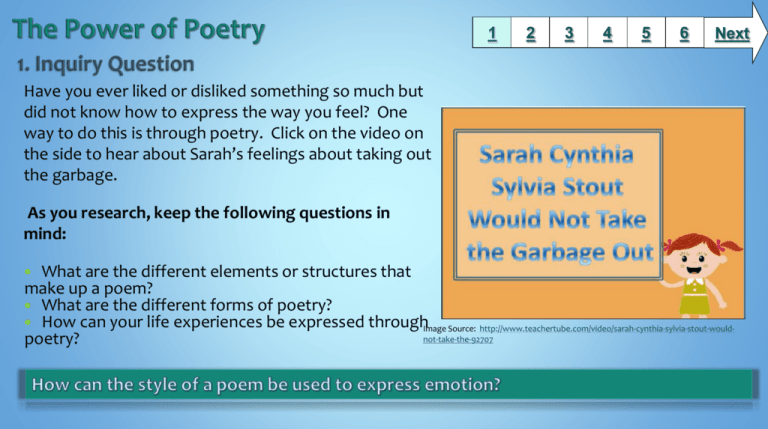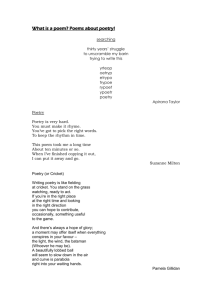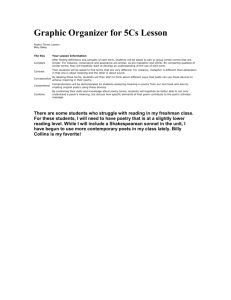
1
2
3
4
5
6
Next
Have you ever liked or disliked something so much but
did not know how to express the way you feel? One
way to do this is through poetry. Click on the video on
the side to hear about Sarah’s feelings about taking out
the garbage.
As you research, keep the following questions in
mind:
What are the different elements or structures that
make up a poem?
What are the different forms of poetry?
How can your life experiences be expressed throughImage Source: http://www.teachertube.com/video/sarah-cynthia-sylvia-stout-wouldnot-take-the-92707
poetry?
1
2
3
4
5
6
Next
Conventions of Poetry
What is poetry?*
*Search for “poetry” in World Book Kids
Conventions of Poetry
Click through and learn about the forms
of poetry.
Haiku
Cinquain
Limerick
Free verse
Diamante
Shape
Narrative
Image Source: https://www.flickr.com/photos/teresa_grau_ros/15238668982
1
2
3
4
5
6
Next
Use the information sources on Slide 2
to …
1) Complete the activity about the
conventions of poetry using the link
“Conventions of Poetry” from Slide 2
2) Then choose 3 of the forms of poetry
that you would like to learn more
about, and fill-in the information
about them on your graphic
organizer.
Image Source: http://nbjenglish.wikispaces.com/THE+VOCABULARY+OF+POETRY
1
2
3
4
5
6
Think back to the forms of poetry you just learned and
wrote about on your graphic organizer…
Now, use your note taking sheet to choose the form of
poetry that best fits something in your life you really
enjoy.
Some examples of topics that you can use in
your poem: pets, sports, food , season, hobbies, and
nature.
Use this rubric to see what your teacher will be looking
for when grading your poem.
Image Source: www.clipart.com by subscription
Next
1
2
3
4
5
6
Famous Children’s Poets
Click through the links below to learn more about
famous children poets:
Shel Silverstein
Kenn Nesbitt
Jon Scieszka
Marilyn Singer
National Poetry Month
Image Source: http://eliseaw.blogspot.com/2010_09_01_archive.html
Learn more about National Poetry Month by
clicking here!
Next
1
Standards Alignment
Common Core State Standards
Reading: 1. Read closely to determine what the text says explicitly and to make logical inferences from it;
cite specific textual evidence when writing or speaking to support conclusions drawn from the text.
Writing: 7. Conduct short as well as more sustained research projects based on focused questions,
demonstrating understanding of the subject under investigation.
3.RL.5- Refer to parts of stories, dramas, and poems when writing or speaking about a text, using terms
such as chapter, scene, and stanza; describe how each successive part builds on earlier sections.
AASL Standards for the 21st Century Learner
1.1.6 Read, view, and listen for information presented in any format (e.g. textual, visual, media, digital) in
order to make inferences and gather meaning.
2.1.3 Use strategies to draw conclusions from information and apply knowledge to curricular areas, realworld situations, and further investigations.
4.1.3 Resound to literature and creative expressions of ideas in various formats and genres.
ISTE NETS - National Educational Technology Standards for Students
3. Research and Information Fluency: Students apply digital tools to gather, evaluate, and use information.
4. Critical Thinking, Problem Solving, and Decision Making: Students use critical thinking skills to plan and
conduct research, manage projects, solve problems, and make informed decisions using appropriate
digital tools and resources.
P21 Skills
Information Literacy: Access information efficiently (time) and effectively (sources); Use information
accurately and creatively for the issue or problem at hand.
ICT Literacy: Use technology as a tool to research, organize, evaluate and communicate information.
Learning and Innovation Skills: Communication & Collaboration: Articulate thoughts and ideas effectively
using oral, written and nonverbal communication skills in a variety of forms and contexts.
2
3
4
5
6
Grade 3rd Content Area: Library Media
Objective: Students will conduct brief, focused research on poem
structure in order to create a poem that effectively expresses their
feelings on the topic of their choice.
Time Frame: about four 50 minute class periods
Differentiation strategies for this lesson:
Direct students to use tools and learning supports included in
our BCPS-licensed databases, such as audio read-aloud and
labeled reading levels/Lexiles. See Digital Content Snapshots &
Support resources on the ODL Resource Wiki as needed.
Silver Star = I can do on my own/Gold Star = Challenge me
Note that all the graphic organizers and resources were created
in Microsoft Word so you can make changes that meet the
needs of your class or your individual students.
Notes to the teacher:
Collaborate with your school library media specialist to
implement this lesson.
Here is a link to a rhyming dictionary your students might need
depending on the poem they are writing.
Here is a great professional resource on teaching the conventions
of poetry from the Poetry Foundation.
Some of the forms of poetry sections have planning worksheets
that might help the students with that particular form of poetry.
See lesson plan guide for the presentation options for the
assessment piece.
Last updated: July 2015
Created by Renee Hartley, Science Teacher
BCPS Slam Dunk Research Model, Copyright 2015, Baltimore County Public Schools, MD, all rights reserved. This lesson may be used for educational, non-profit school use only.
All other uses, transmissions, and duplications are prohibited unless permission is granted expressly. This lesson is based on Dr. Jamie McKenzie’s Slam Dunk Digital Lesson model.




